December 2025
The global petrochemicals-market size was valued at USD 659.55 billion in 2024, grew to USD 700.05 billion in 2025, and is expected to hit around USD 1,196.85 billion by 2034, growing at a compound annual growth rate (CAGR) of 6.14% over the forecast period from 2025 to 2034. The growing investment in petrochemical facilities and the increasing demand for petrochemical-based products drive the market growth.
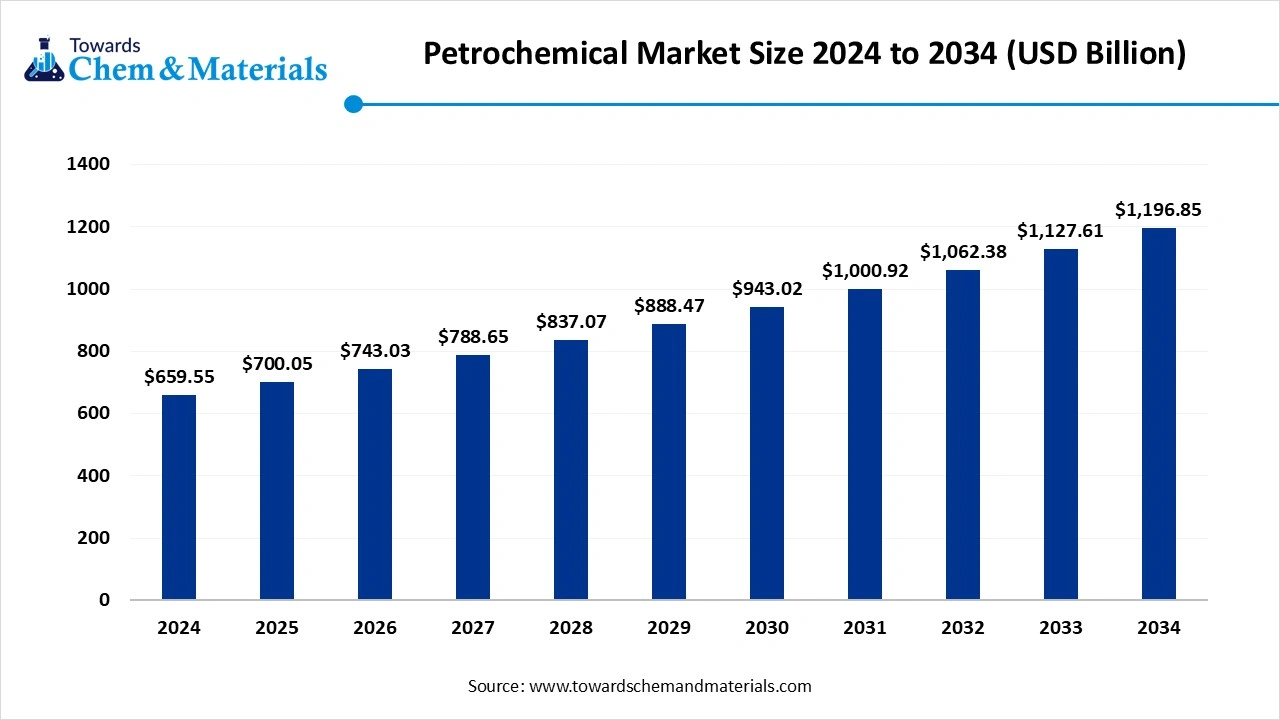
Petrochemicals are obtained from natural gas and crude oil for the production of various materials like synthetic fibers, detergents, plastics, fuels, and solvents. Petrochemicals are derived into two types: aromatics like xylene, benzene, & toluene, and olefins like propylene & ethylene. They are widely used in various applications like manufacturing plastic products, production of synthetic fibers, manufacturing chemicals, food preservation, lightweight automotive components, and many more.
Factors driving the market growth are growing industrialization, rapid urbanization, growth in e-commerce, increasing consumption of consumer goods, high availability of feedstocks, increasing development of energy storage systems, rise in adoption of electric vehicles, and increasing utilization of electronic devices.
The rapid urbanization and growing construction activities in various regions increase demand for petrochemicals for various applications. The growing investment in the development of infrastructure projects and the increasing construction of new homes increase demand for petrochemicals. The increasing need for insulation, paints, adhesives, coatings, and piping requires petrochemicals to enhance energy efficiency and improve the aesthetics of buildings.
The strong focus on interior design and increasing development of window frames increases the adoption of petrochemicals. The growing utilization of energy-efficient construction materials and the rise in commercial & residential construction require petrochemicals. The growing construction activities are a key driver for the growth of the market.
| Report Attributes | Details |
| Market Size in 2025 | USD 700.05 Billion |
| Expected size in 2034 | USD 1,196.85 Billion |
| Growth Rate | CAGR 6.14% |
| Base Year in Estimation | 2024 |
| Forecast Period | 2025-2034 |
| High Impact Region | Asia Pacific |
| Segment Covered | By Product Type, By Raw Material, By Manufacturing Process, By End-Use Industry, By Region |
| Key Companies Profiled | BASF SE, Dow Chemical Company, SABIC, LyondellBasell Industries, ExxonMobil Chemical, INEOS Group, Sinopec, Reliance Industries Limited (RIL), Shell Chemicals, TotalEnergies Chemicals, Formosa Plastics Group, Mitsubishi Chemical Group, LG Chem, Covestro AG, Braskem S.A., Arkema S.A., Chevron Phillips Chemical, PTT Global Chemical, Mitsui Chemicals, Hanwha Solutions |
The growing electronic sector and the rise in the adoption of electronic devices increase demand for petrochemicals. The increasing production of electronic components like cables, circuit boards, microchips, connectors, and advanced semiconductors increases the adoption of petrochemicals. The growing development of lightweight electronic devices and the increasing miniaturization of electronic devices require petrochemicals.
The increasing adoption of devices like tablets, smartphones, wearables, and laptops, and ongoing innovations in electronics, increase the adoption of petrochemicals. The growing need for electrical insulation in electronic devices and the development of flexible displays require petrochemicals. The growing electronic industry creates an opportunity for the growth of the petrochemicals market.
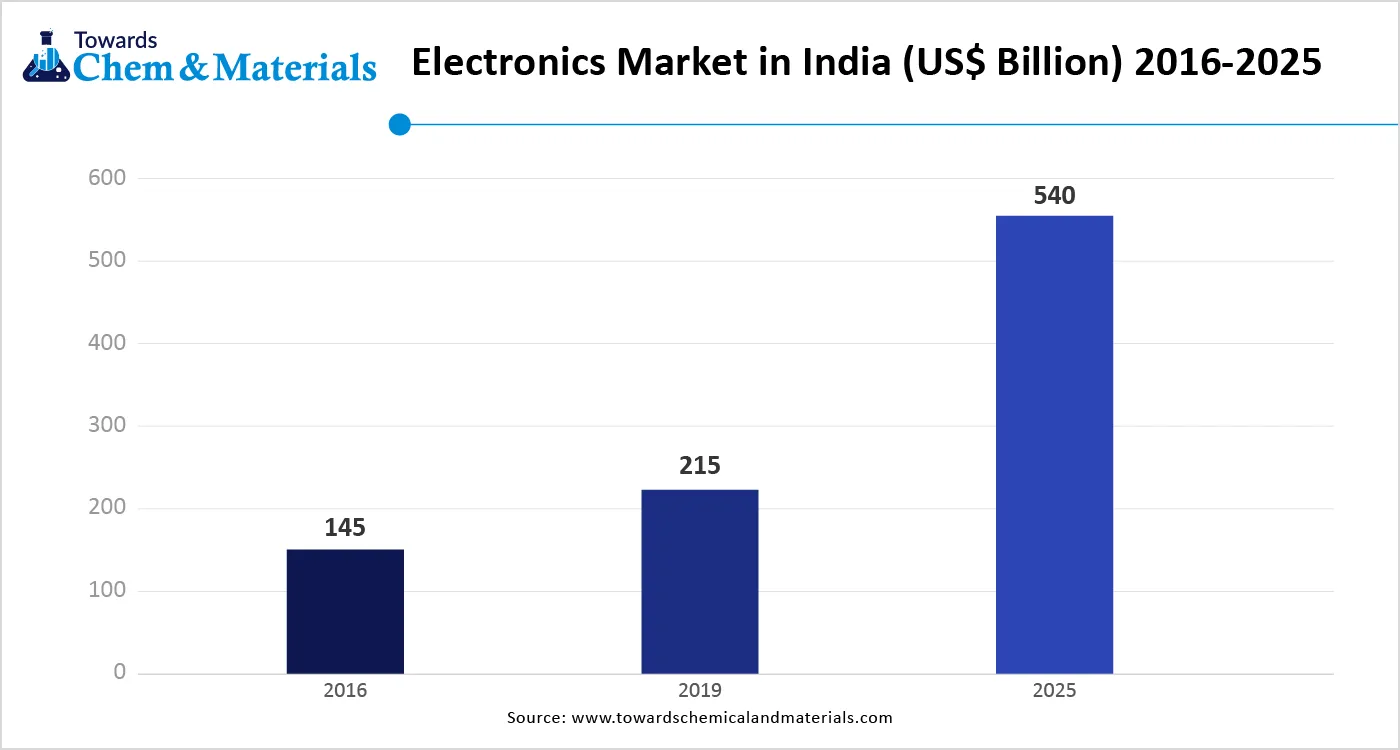
Despite several benefits of the petrochemicals in various industries, the fluctuating cost of raw materials restricts the market growth. The volatility in prices of raw materials like natural gas and crude oil directly affects the market. Supply chain disruptions due to factors like natural disasters, logistical issues, wars, and trade restrictions increase the raw material cost. The geopolitical instability and increasing cost of energy increase the cost. The stringent changes in regulations and variations in feedstock availability require a high cost. The fluctuating raw material prices hamper the growth of the market.
Asia Pacific Petrochemicals Market Size, Industry Report 2034
The Asia Pacific petrochemicals market size was estimated at USD 336.37 billion in 2024 and is projected to reach USD 611.11 billion by 2034, growing at a CAGR of 6.16% from 2025 to 2034.Asia Pacific dominated the petrochemicals market with approximately a 51% share in 2024.
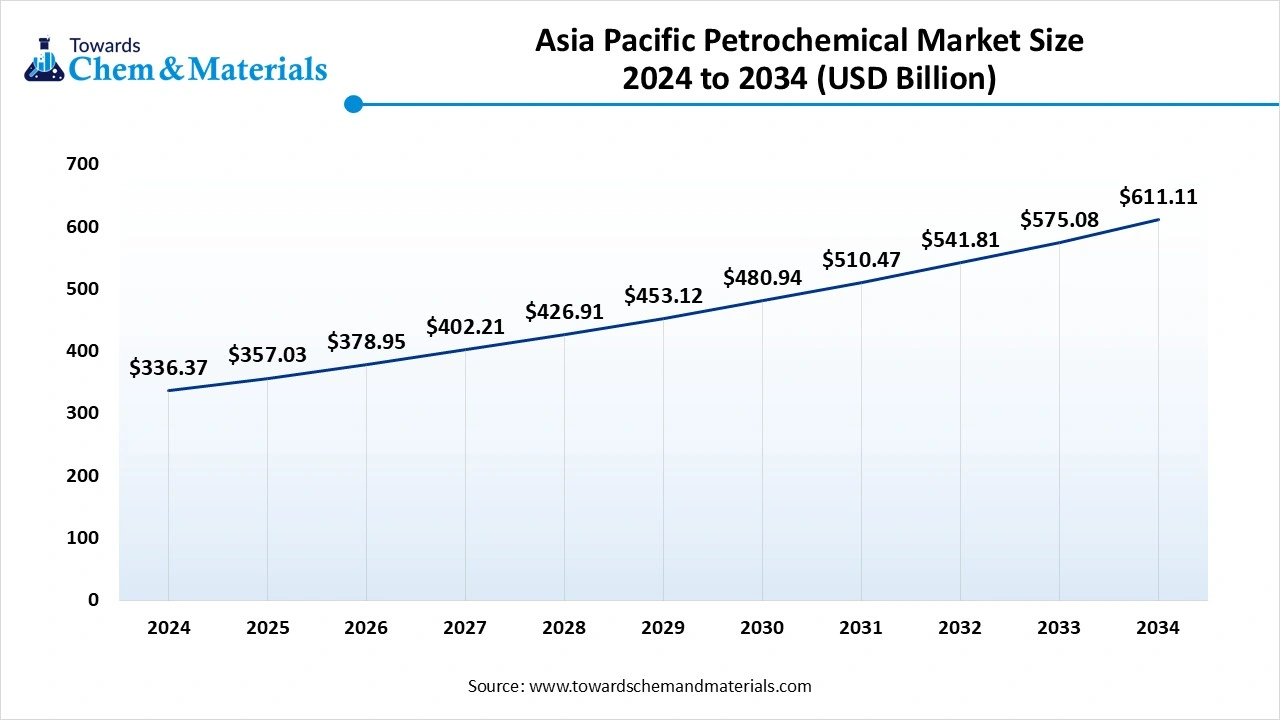
The growing industrialization and presence of abundant raw materials in the region increase the production of petrochemicals. The high government investment in petrochemical infrastructure and increasing demand for petrochemical-based products help the market growth. The growing expansion of the packaging industry and growth in construction activities require petrochemicals. The increasing automotive manufacturing and growing development of infrastructure projects drive the overall market growth.
China Petrochemicals Market Trends
China is a major contributor to the market. The growing expansion of the petrochemical industry and high investment in petrochemical facilities help the market growth. The growing sectors like consumer durables, construction, and automobiles increase demand for petrochemicals. The increasing need for products like synthetic fibers & plastics, and the presence of vast reserves of coal, increase the production of petrochemicals, supporting the overall market growth.
Middle East & Africa Petrochemicals Market Trends
The Middle East & Africa are experiencing the fastest growth in the market during the forecast period. The presence of abundant hydrocarbons and the low cost of production increase the development of petrochemicals. The increasing investment in petrochemical projects and growing industrialization increase demand for petrochemicals. The growth in the development of infrastructure projects and the strong presence of a petrochemical plant in Qatar & Saudi Arabia drive the overall market growth.
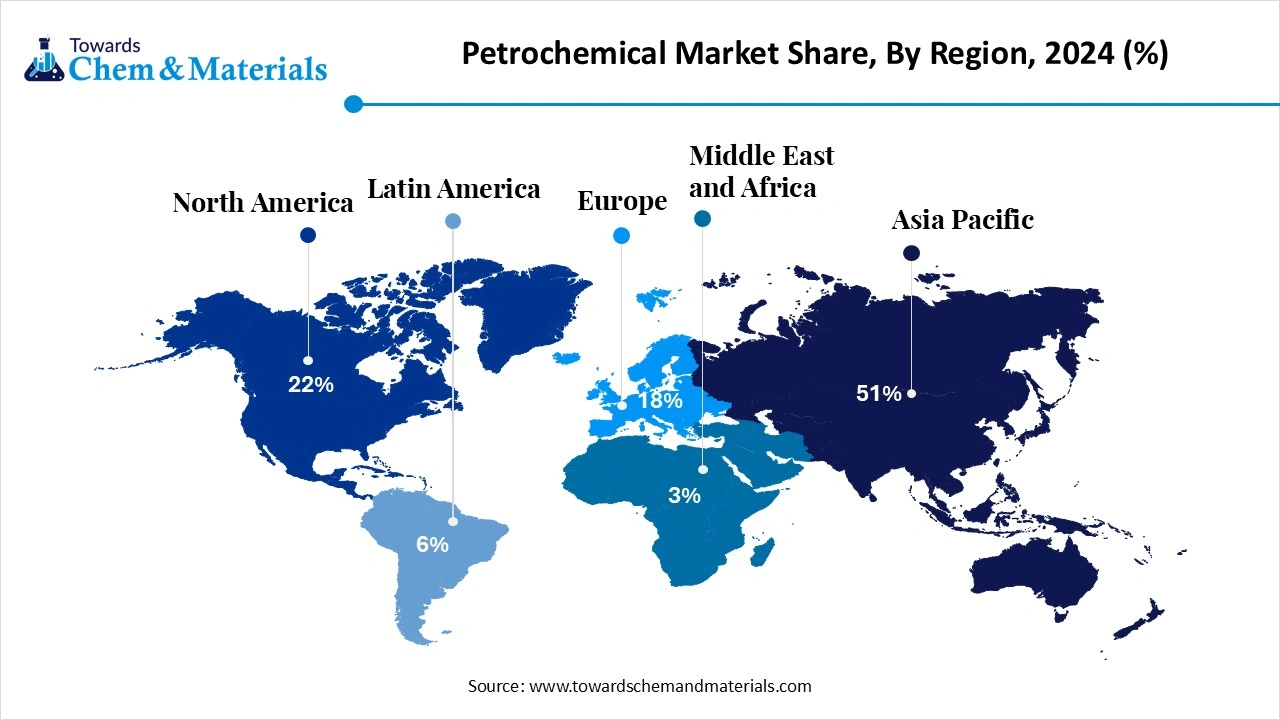
South Africa Petrochemicals Market Trends
South Africa is a key contributor to the market. The vast reserves of coal and the presence of CTL technology increase the production of petrochemicals. The increasing construction activities and growth in automotive manufacturing increase demand for petrochemicals. The growing industrial activities and the growing expansion of the packaging industry increase the adoption of petrochemicals, supporting the overall market growth.
Why did the Olefins Segment Dominate the Petrochemicals Market?
The olefins segment dominated the market with approximately a 44% share in 2024. The increasing production of various polymers and plastics increases demand for olefins. The presence of vast reserves of natural gas and the increasing development of lightweight vehicle materials increase demand for olefins. The growing expansion of the packaging industry and rise in construction activities increase the adoption of olefins, driving the overall market growth.
The polypropylene & bio-based olefins segment is the fastest-growing in the market during the forecast period. The growing expansion of the packaging industry and increasing construction activities increase demand for PP. The increasing production of automotive components, films, and containers increases demand for PP. The growing environmental concerns and stricter environmental regulations increase the adoption of bio-based olefins. The focus on lowering the carbon footprint and minimizing greenhouse gas emissions supports the market growth.
The crude oil segment held the largest revenue share of approximately 52% in the market in 2024. The presence of vast reserves of hydrocarbon and the increasing utilization of steam cracking increase demand for crude oil. The increasing production of synthetic fibers, detergents, and plastics requires crude oil. The high availability of feedstocks and growth in industries like consumer goods, packaging, and construction require crude oil, driving the overall market growth.
The natural gas & naphtha alternatives segment is experiencing the fastest growth in the market during the forecast period. The growing demand for products like clothing, plastics, and fertilizers increases the adoption of natural gas. The increasing environmental concerns and high availability of natural gas liquids help the market growth. The increasing shift towards cleaner processes and the increasing adoption of sustainable processes increase demand for natural gas & naphtha alternatives, supporting the overall market growth.
Why Steam Cracking Segment is Dominating the Petrochemicals Market?
The steam cracking segment dominated the petrochemicals market with approximately a 48% share in 2024. The increasing production of light olefins and increasing processes of hydrocarbon feedstock increase demand for steam cracking. The growing manufacturing of ethane, naphtha, and LPG requires steam cracking. The increasing use of household items like shampoos and detergents increases demand for steam cracking. The growing production of downstream products and cost-effectiveness drive the market growth.
The methanol-to-olefins segment is the fastest-growing in the market during the forecast period. The increasing need for construction materials and the production of automotive components increases demand for MTO. The focus on energy security and the presence of diverse feedstocks increase the adoption of MTO. The strong focus on lowering oil dependency and the need to minimize carbon footprint increase the adoption of MTO. The growing utilization of plastics and the expansion of the packaging industry require MTO, supporting the market growth.
Which End-Use Industry Held the Largest Share in the Petrochemicals Market?
The packaging segment held the largest revenue share of approximately 29% in the petrochemicals market in 2024. The growing demand for packaged goods and the increasing consumption of packaged food increases demand for petrochemicals. The rise in the e-commerce sector and focus on extending the shelf life of packaged products increase the adoption of petrochemicals. The growing packaging of chemicals, fertilizers, non-food items, and lubricants drives the overall market growth.
The automotive & EV materials segment is experiencing the fastest growth in the market during the forecast period. The increasing manufacturing of lightweight vehicle components like interior trims, bumpers, and dashboards increases demand for petrochemicals. The focus on lowering vehicle weight and the rise in the adoption of electric vehicles increase demand for petrochemicals. The growing expansion of EV infrastructure and increasing manufacturing of battery components support the overall market growth.
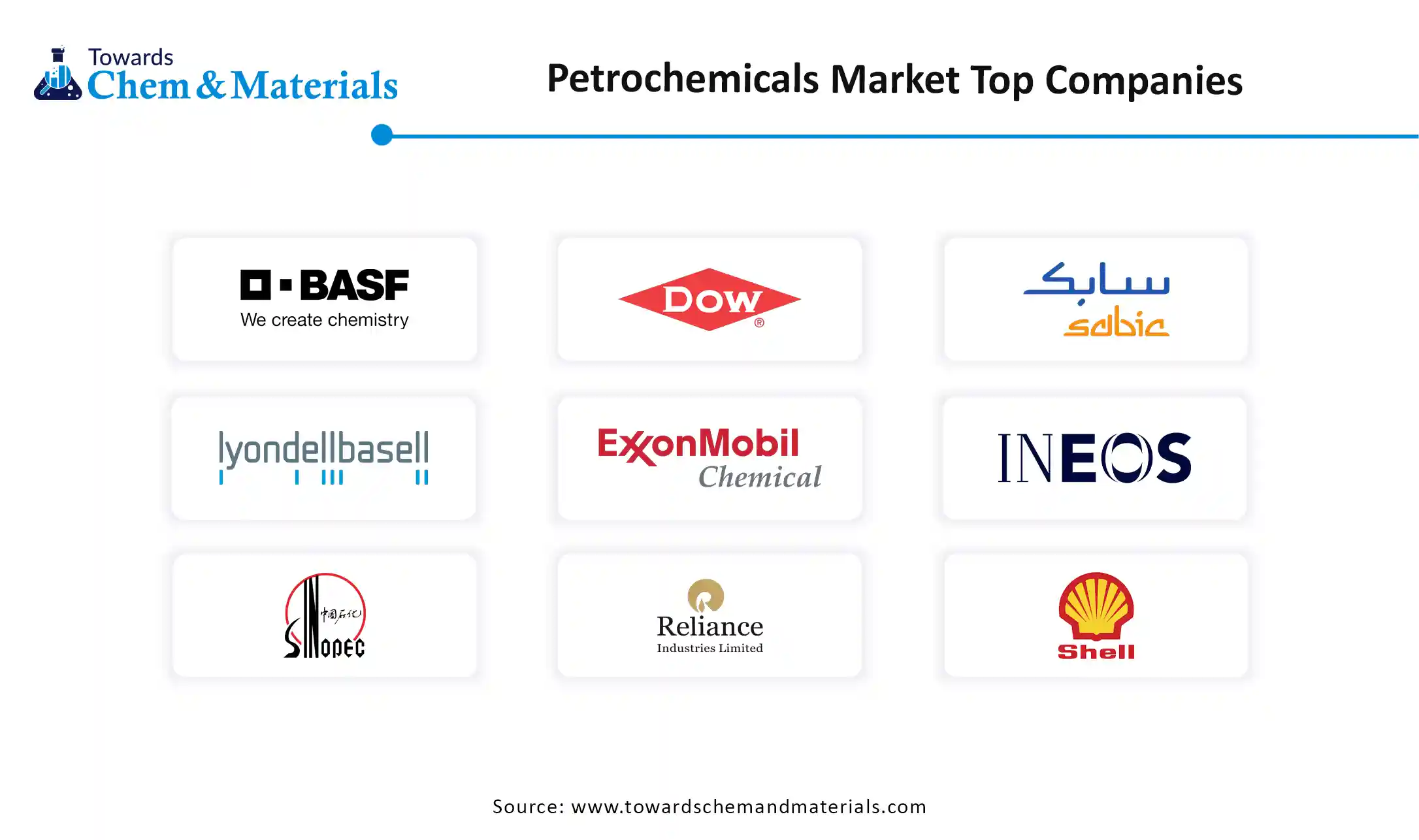
By Product Type
By Raw Material
By Manufacturing Process
By End-Use Industry
By Region
December 2025
December 2025
December 2025
December 2025